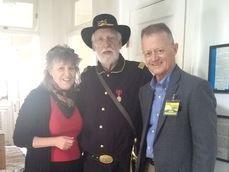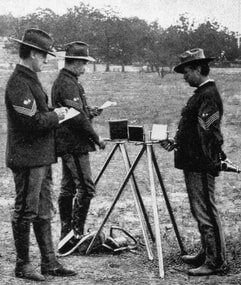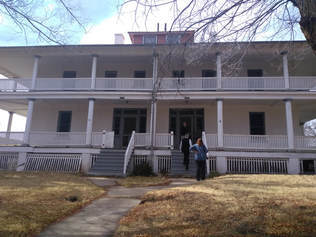A Fort With Many Functions
 My husband and I with Rocky, one of the historical interpreters at Ft. Bayard As some of you know, my husband, Hank Bohnhoff, is a judge on the New Mexico Court of Appeals, and he has to run for election this year in order to keep his seat on the bench. Part of running for election is getting out and meeting constituents, and so we've been doing a lot of road trips this past year.
My husband and I with Rocky, one of the historical interpreters at Ft. Bayard As some of you know, my husband, Hank Bohnhoff, is a judge on the New Mexico Court of Appeals, and he has to run for election this year in order to keep his seat on the bench. Part of running for election is getting out and meeting constituents, and so we've been doing a lot of road trips this past year.Last month we visited the southwestern part of the state, and I had the joy of getting to make a short stop at Fort Bayard. I am always grateful when a trip includes a little history.
The Fort was named for General George D. Bayard, a West Point graduate who had been killed at Fredericksburg. Begun in 1866, the first fort constructed on the site was a collections of tents and crude adobe buildings thrown up by Company B the 125th United States Colored Infantry. Many of the soldiers stationed here were Buffalo Soldiers.

 US soldiers were still using the heliograph in 1898, when this photo was taken. The fort protected settlements in Southern New Mexico from raids by the various Apache tribes who roamed the rugged mountains of the Gila. It was also one of 24 heliograph stations, which relayed messages between forts by means of the sun and a mirror that was used to flash out Morse code signals. Although less technologically advanced, the heliograph system worked better than the newly installed telegraph system, because the Apaches could cut telegraph wires but they could not meddle with the sun. It is of interest that the man charged with establishing the heliograph stations was a young Second Lieutenant named John J. Pershing, who would go on to become the famous Blackjack Pershing.
US soldiers were still using the heliograph in 1898, when this photo was taken. The fort protected settlements in Southern New Mexico from raids by the various Apache tribes who roamed the rugged mountains of the Gila. It was also one of 24 heliograph stations, which relayed messages between forts by means of the sun and a mirror that was used to flash out Morse code signals. Although less technologically advanced, the heliograph system worked better than the newly installed telegraph system, because the Apaches could cut telegraph wires but they could not meddle with the sun. It is of interest that the man charged with establishing the heliograph stations was a young Second Lieutenant named John J. Pershing, who would go on to become the famous Blackjack Pershing.
 Some of the officer's housing. Once the Indian Wars were over, Fort Bayard became the first military sanatorium for the treatment of tuberculosis. Doctors at the time believed that high elevation, clean air, abundant sunshine and low humidity were all beneficial to the treatment of this disease. The Fort's population grew during World War I, when soldiers who had suffered from poisonous gas attacks crowded the wards. The nurses' quarters, which housed a matron responsible for the moral well-being of the women who tended the sick and injured, was relocated a distance from the other buildings after many nurses fell in love with patients.
Some of the officer's housing. Once the Indian Wars were over, Fort Bayard became the first military sanatorium for the treatment of tuberculosis. Doctors at the time believed that high elevation, clean air, abundant sunshine and low humidity were all beneficial to the treatment of this disease. The Fort's population grew during World War I, when soldiers who had suffered from poisonous gas attacks crowded the wards. The nurses' quarters, which housed a matron responsible for the moral well-being of the women who tended the sick and injured, was relocated a distance from the other buildings after many nurses fell in love with patients.During WWII, German Prisoners of War lived here, repairing buildings, tending the orchard, and caring for the burial grounds that became a National Cemetery in 1976. The fort continued to serve as a long-term care facility for veterans and civilians alike after it was transferred from Federal to State control in 1965. Finally, in 2010, a more modern medical facility was built just down the road.
Fort Bayard is set in a beautiful, mountainous setting, with wide, blue skies and big vistas. The buildings are in disrepair but to me, it is a glorious place, filled with historical narratives. It could be the setting for a "wild west" story, a love story between a young gas victim and a nurse, a story of longing for home by a young German POW. The possibilities are endless.
 My husband in Fort Bayard's cemetery. We found gravestones from the Spanish American War, World War I and II, Vietnam, and more recent conflicts.
My husband in Fort Bayard's cemetery. We found gravestones from the Spanish American War, World War I and II, Vietnam, and more recent conflicts.
Published on March 06, 2018 02:30
No comments have been added yet.



